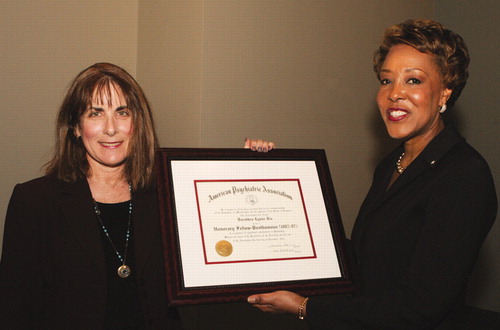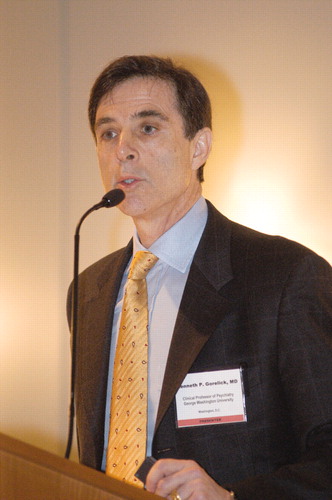History of St. Elizabeths Parallels U.S. Psychiatry's
In its 150 years, St. Elizabeths Hospital has mirrored the best and worst of the history of American psychiatry. The great reformer Dorothea Dix founded“ The Government Hospital for the Insane,” dreaming that the government might provide, in her words, “the most humane care and enlightened curative treatment of the insane of the Army, Navy and the District of Columbia,” said Kenneth P. Gorelick, M.D., a clinical professor of psychiatry at George Washington University and a historian of the institution. Situated on a tract of land in the southeast quadrant of the city, the hospital opened its doors in 1855, and its original buildings are now a National Historic Landmark.

In reality, said Gorelick at the sesquicentennial celebration of the hospital's birth last month, “St. Elizabeths was bedeviled by having to do too much for too many with too little.”
Gorelick spoke at a symposium organized by program chair Liza H. Gold, M.D., a clinical associate professor of psychiatry at Georgetown University School of Medicine. The symposium was sponsored by APA, in conjunction with the Medical and Professional Society of St. Elizabeths Hospital. A number of local mental health organizations provided support, including the psychiatric societies of Maryland, Virginia, and Washington, D.C., as well as the Chesapeake Bay Chapter of the American Academy of Psychiatry and the Law. Coordinating the symposium for APA was the Corresponding Committee on History and Library, chaired by Avram Mack, M.D., with the assistance of APA's director of Library and Archives, Gary McMillan.
Idealism Applied
The hospital's first quarter century saw the initial fulfillment of Dix's dream. She played a role in establishing 30 of the 60 mental asylums built in the United States during her lifetime. Active psychosocial treatment and decent accommodations helped stop mentally ill persons from being locked up in attics and jails or from wandering the countryside.
The hospital's first superintendent, Charles Nichols, M.D., built pleasant, detached buildings based on the Kirkbride model, which called for symmetrical wings of asylum buildings to be stepped back in a shallow V-shape. Patients worked in greenhouses as part of their therapy, growing flowers for the wards.
Later, the psychological and emotional casualties of the Civil War found their way to St. Elizabeths during and after that conflict.
During this era, St. Elizabeths also began its association with notorious, criminally mentally ill individuals—of whom Ezra Pound and John Hinckley were the most prominent 20th-century examples. Richard Lawrence, who tried to assassinate President Andrew Jackson on January 30, 1835, was found not guilty by reason of insanity and spent 20 years in a Maryland hospital before becoming patient number seven at St. Elizabeths.
In 1885 the trial of Charles Guiteau, the assassin of President Chester Alan Arthur, saw dueling psychiatric witnesses, including superintendent William Godding, M.D., argue over the culpability of the accused. Guiteau was found guilty and hanged. Godding then attended Guiteau's autopsy, which revealed changes in his brain caused by tertiary syphilis.
Increasing rates of neurosyphilis through the 19th century probably contributed to the rising number of people who became mentally ill, according to medical historians. Partly as a result of his experience with the Guiteau case, Godding hired neuropathologist Isaac W. Blackburn, M.D., to investigate the biology of psychopathology in the first pathology laboratory in a U.S. mental hospital.
The hopes of this early age of idealism remained, but social and financial support for care was lost, overwhelmed by the number of chronic patients accumulating in the absence of curative treatments, said Gorelick. By the end of the 19th century, St. Elizabeths had become a warehouse for the insane, with patients sleeping on straw pallets and working on the hospital farm to provide funds for the institution. The arrival of William Alanson White, M.D., in 1903 began a new era.
“White embraced psychoanalysis as early as 1908,” said Gorelick. “He was open-minded but saw no panaceas coming from the biological side. Thus, he tilted to a new hope of understanding through the thoughts and feelings and stories of patients.”
In the years just before and after World War II, St. Elizabeths housed nearly 7,000 patients. Under Winfred Overholser, M.D., St. Elizabeths, like other progressive mental hospitals, became a self-contained therapeutic community with patient self-government and arts therapies, even as the worst asylums descended into the “snake pits” that shocked the nation.
Community Care, Research Increase
In the postwar years, St. Elizabeths' location in the District of Columbia began to make it more of a city hospital and less of a federal one, as places for the city's mentally ill citizens declined with deinstitutionalization, said William Prescott, M.D., a former assistant U.S. surgeon general and the last superintendent of the hospital under U.S. government control. St. Elizabeths changed from the equivalent of a large state mental hospital to a large community mental health center over two decades in the 1960s and 1970s.
At the same time, the hospital served as the incubator for a wide range of neuropsychiatric research, said Daniel Weinberger, M.D., now at the National Institute of Mental Health (NIMH).
“This was the site of a premier schizophrenia research program,” said Weinberger, who worked at St. Elizabeths for 20 years.“ Basic and clinical scientists worked side by side.”
St. Elizabeths saw the birth of neuroimaging in the United States, he said, including the first use of CT scans in schizophrenia research, followed by studies using regional cerebral blood flow, magnetic resonance imaging, single photon emission computed tomography, and whole brain scans using functional magnetic resonance imaging. Other milestones included work in frontal lobe physiology, neurocircuitry models, neurodevelopmental theory, and the genetics of mental disease.


The use of the work of Paul Luisada by St. Elizabeths' NIMH researchers provided another example of cooperation between clinic and lab at the institution, said Roger Peele, M.D., a clinical professor of psychiatry and behavioral sciences at George Washington University and APA's Area 3 trustee. Peele started as an intern at St. Elizabeths in 1960 and eventually held a number of positions there, including directing the hospital.
In the early 1970s, Luisada noticed that phencyclidine (PCP) use was causing a schizophrenia-like illness among his patients at St. Elizabeths. Weinberger and other NIMH researchers on the grounds of the hospital facilitated the exploration of phencyclidine's psychotomimetic effects. Today, said Peele, those effects are known to act on the glutamate system, and future medications for people with schizophrenia will focus on countering these effects.
In 1973 Armando Saenz, M.D., initiated an outpatient commitment option that resulted in fewer hospitalizations than comparable approaches, said Peele.“ For the next 25 years, St. Elizabeths used the outpatient commitment option better than anyone. This was ideal for patients and was achieved without any increase in costs.”
St. Elizabeths Becomes a D.C. Facility
The decision to transfer control of the institution in 1987 from the federal government to the District of Columbia was made too abruptly, and largely for political reasons, said Prescott. An inexperienced D.C. government, still finding its footing in the wake of its transition to home rule and buffeted by a fiscal crisis, was left with layoffs, a deteriorating infrastructure, and declining patient care at St. Elizabeths, said Martha Knisley, the director of the D.C. Department of Mental Health.
“We had to fight such a difficult battle on the other side of the wall to keep providing world-class care and research on the inside,” said Knisley.
The battles included disputes with Medicare and Medicaid over $325 million that the District had claimed for patient care, outpatient services, and services for federal prisoners being treated for mental illness. Nevertheless, the city has put $10 million into the renovation of existing facilities and will soon start construction of a 300,000-square-foot hospital for evaluation, patient care, and forensic services. Currently, St. Elizabeths houses 248 civil and 206 forensic patients, said a department spokesperson.
Regardless of the value of community mental health care, there will always be a need for long-term inpatient care, said E. Fuller Torrey, M.D., associate director for laboratory research at the Stanley Medical Research Institute in Bethesda, Md, and a member of the St. Elizabeths' clinical staff from 1977 to 1986.
“Deinstitutionalization was not an utter failure—just for 50 percent of the patients,” Torrey said. He pointed that out that people with mental illness are still being institutionalized—but not in psychiatric hospitals.
“The largest psychiatric institution in D.C. is the jail,” he said, given that a third of prisoners in the D.C. prison system are taking psychotropic medications.
Torrey concluded his remarks by pointing out, “There will continue to be a need for public psychiatric hospitals for the long-term care of a small subset of individuals with severe psychiatric disorders.”
More information on St. Elizabeths and its sesquicentennial is posted online at<www.seh150.org/index.htm>.▪



